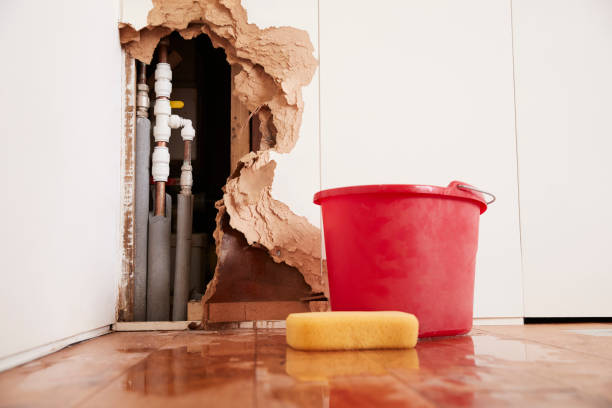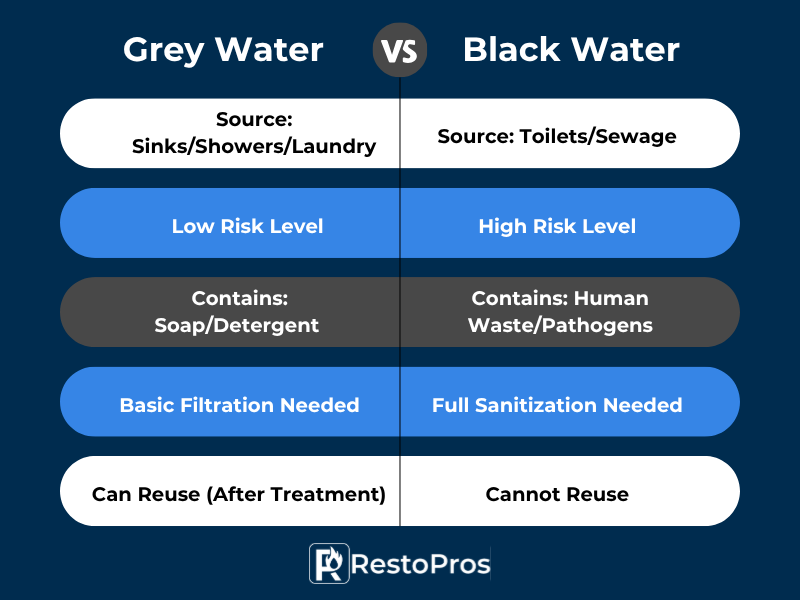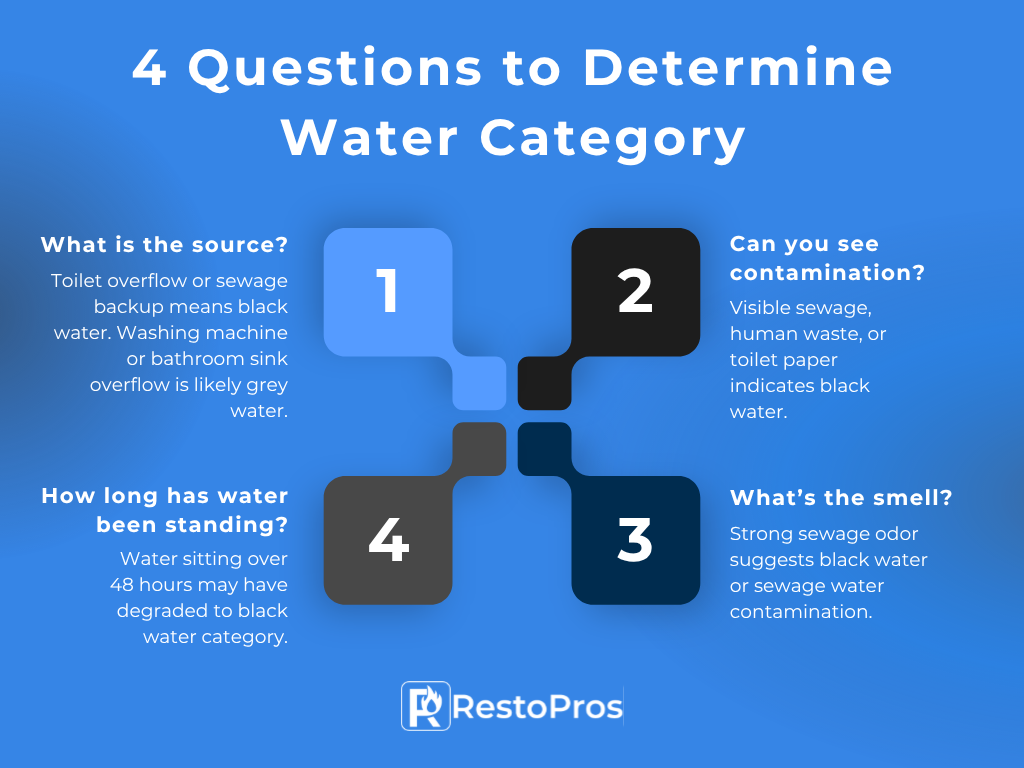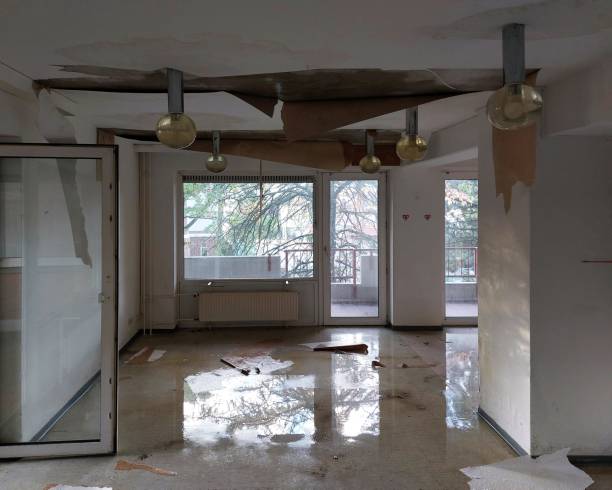The Short Answer: When water damage occurs in your home or business, not all water is equally dangerous. Grey water comes from sources like bathroom sinks, showers, and washing machines, and contains some contaminants. Black water is the most dangerous type, containing sewage water, human waste, and harmful pathogens that pose serious health risks. Understanding which type of water has flooded your property determines the safety precautions and professional cleanup methods required.
When dealing with water damage in your property, identifying the type of wastewater helps you understand the health risks and necessary safety measures. Property owners face various water-related emergencies, from pipe bursts to sewer backups, and knowing whether you’re dealing with grey water or black water determines how dangerous the situation is and what cleanup procedures are required.
This guide explains everything you need to know about grey water and black water damage, including their sources, health risks, and why professional treatment is necessary. Whether you’re a homeowner dealing with a flooded basement or a property manager responding to water emergencies, this information will help you understand the severity of the situation and take appropriate action.

Understanding Greywater Damage
Grey water represents the middle category of water contamination. This wastewater comes from household activities that don’t involve human waste or sewage. While grey water isn’t as dangerous as black water, it still contains contaminants that require careful handling and professional cleanup.
Common Sources of Grey Water
Grey water damage in homes and businesses typically originates from:
Bathroom Sources:
- Bathroom sink overflows from clogged drains
- Shower and bathtub water from drain backups
- Water from washing machines during malfunctions or overflow
Kitchen Sources:
- Kitchen sink backups containing food particles, grease, and dish soap
- Dishwasher leaks or overflows with detergent and organic matter
Other Sources:
- Laundry facilities water containing laundry detergent and dirt from clothes
- Water from sump pump failures that mix with grey water drainage
What Grey Water Contains
The contamination in grey water varies based on its source but generally includes:
- Soap, shampoo, and cleaning product residues
- Food particles and grease from kitchen activities
- Laundry detergent and fabric softeners
- Dirt and organic matter from washing
- Low to moderate levels of bacteria
- Chemical residues from household products
Health Risks of Grey Water
While grey water is less hazardous than black water, it still poses health concerns. The bacteria levels are moderate, and prolonged exposure can cause skin irritation, minor infections, or gastrointestinal issues if ingested. If grey water sits untreated for 48 hours or more, bacterial growth increases significantly, and it can degrade into black water category contamination.
Grey Water Cleanup Requirements
Professional water damage restoration for grey water involves:
- Protective equipment for technicians including gloves and boots
- Extraction of all standing water
- Removal of porous materials that absorbed grey water
- Antimicrobial treatment of affected surfaces
- Thorough drying and dehumidification
- Air quality testing to ensure safe conditions
Blackwater: The Most Dangerous Water Damage
Black water represents the highest risk category of water contamination. This highly hazardous wastewater poses immediate and serious health threats to anyone exposed. Black water damage requires immediate professional intervention and should never be handled by property owners.
Sources of Blackwater in Properties
Black water damage commonly occurs from:
Sewage-Related Sources:
- Toilet overflows containing human waste and toilet paper
- Sewage system backups into basements or lower levels
- Septic system failures that release wastewater into the property
- Sewer line breaks that flood areas with sewage water
Flooding Sources:
- River, stream, or storm flooding that mixes with sewage
- Rising groundwater that contacts septic tanks or sewer lines
- Storm surge bringing contaminated flood water into buildings
Contaminated Standing Water:
- Any grey water that has sat untreated for over 48 hours and developed dangerous bacterial growth
- Water that has mixed with faecal matter or raw sewage
Dangerous Contaminants in Black Water
Black water carries numerous disease-causing organisms and toxic substances:
- Bacteria: E. coli, salmonella, and other harmful pathogens
- Viruses: Hepatitis, norovirus, and other serious illness-causing viruses
- Parasites: Giardia, cryptosporidium, and parasite eggs
- Toxic organic matter: Decaying waste and faecal matter
- Chemicals: Pesticides, heavy metals, and industrial contaminants from sewage water
- Fungi and mold spores: That thrive in contaminated environments
Severe Health Risks
Exposure to black water can cause:
- Severe gastrointestinal illnesses and infections
- Respiratory problems from airborne contaminants
- Skin infections and rashes
- Hepatitis and other serious viral infections
- Parasitic infections
- Long-term health complications
Even brief contact with black water or breathing vapors from black water contamination can make you seriously ill. Children, elderly individuals, and those with compromised immune systems face especially high risks.
Why Black Water Requires Professional Treatment
Black water cleanup is not a DIY project. Professional restoration companies like RestoPros have:
Specialized Equipment:
- Industrial-grade pumps for safe water extraction
- Professional-grade disinfectants and sanitizers
- Air scrubbers to remove contaminated particles
- Moisture detection equipment
Proper Safety Protocols:
- Full protective equipment including hazmat suits, respirators, and waterproof boots
- Containment procedures to prevent contamination spread
- Safe disposal methods for contaminated materials
- Chemical treatment applications for thorough sanitization
Required Expertise:
- Knowledge of health regulations and proper disposal procedures
- Understanding of wastewater treatment requirements
- Ability to assess structural damage from sewage exposure
- Documentation for insurance and health department compliance

Professional Treatment and Cleanup Protocols
Grey Water Treatment Process
Professional teams treating grey water damage follow systematic procedures:
- Assessment: Technicians identify the water source and contamination level
- Containment: Affected areas are isolated to prevent spread
- Extraction: All standing water is removed using professional pumps
- Removal: Porous materials like carpet padding and drywall that absorbed contaminated water are removed
- Cleaning: All surfaces receive antimicrobial treatment
- Drying: Industrial dehumidifiers and air movers eliminate moisture
- Testing: Air quality and moisture levels are verified before completion
Black Water Treatment Requirements
Black water remediation demands more intensive treatment:
- Safety Setup: Full protective gear and containment barriers are established
- Extraction: Specialized pumps remove sewage water and solid waste
- Disposal: Contaminated water goes to wastewater treatment facilities
- Material Removal: All porous materials contacted by black water must be disposed of; they cannot be salvaged
- Deep Sanitization: Multiple rounds of chemical treatment with EPA-approved disinfectants
- Air Scrubbing: Professional equipment removes airborne contaminants
- Testing and Verification: Multiple tests confirm the area meets safety standards
- Documentation: Detailed records prove proper remediation for insurance and health departments
Safety Standards and Regulations
Professional water damage companies must follow strict protocols:
- OSHA Requirements: Proper handling of biohazardous materials and worker safety
- EPA Standards: Approved disinfectants and disposal methods
- Local Health Codes: Proper reporting and documentation of sewage contamination
- IICRC Certification: Industry standards for water damage restoration
- Insurance Requirements: Detailed documentation and testing results
Environmental Impact Considerations
Proper handling of contaminated water protects the environment:
- Contaminated water must be disposed of through approved wastewater treatment systems
- Sewage treatment plants process black water to remove contaminants before discharge
- Proper disposal prevents environmental impact on local water sources and aquatic ecosystems
- Professional companies ensure contaminated materials don’t enter storm drains or natural waterways
Identifying Water Damage Categories in Your Property

Initial Assessment Steps
When water damage occurs, determine the category by asking:
- What is the source? Toilet overflow or sewage backup means black water. Washing machine or bathroom sink overflow is likely grey water.
- Can you see contamination? Visible sewage, human waste, or toilet paper indicates black water.
- What’s the smell? Strong sewage odor suggests black water or sewage water contamination.
- How long has water been standing? Water sitting over 48 hours may have degraded to black water category.
When to Evacuate
Leave the property immediately if:
- You see sewage water or human waste
- There’s a strong sewage smell
- Water came from toilet or sewer backup
- You’re unsure of the water source
- Anyone feels ill after exposure
Documentation for Insurance
Before professionals arrive:
- Take photos and videos from a safe distance
- Note the water source if known
- Document when flooding started
- List affected areas and belongings
- Do NOT enter contaminated areas for closer documentation

Take Action Now: Professional Water Damage Response
Understanding the difference between grey water and black water is critical for your safety. Grey water from sources like washing machines, bathroom sinks, and kitchen sinks requires professional cleanup to prevent health issues. Black water containing sewage water and human waste is extremely dangerous and demands immediate professional response.
Never attempt to clean up black water yourself. The health risks are too severe, and improper cleanup can leave dangerous contamination behind. Even grey water cleanup benefits from professional equipment and expertise that ensures thorough sanitization.
When water damage happens in your home or business, RestoPros’ IICRC-certified technicians respond 24/7 with the proper equipment and safety protocols. Our team safely handles both grey and black water emergencies, following all health regulations and environmental standards to restore your property to safe, clean conditions.
For immediate water damage assistance, contact RestoPros. Our emergency response team is ready to assess your situation and begin professional treatment right away. Don’t risk your health; let our trained professionals handle contaminated water safely and effectively.
